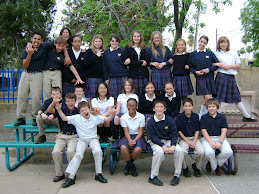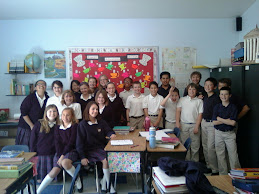Sometimes our understanding of the written word is more deeply understood through the visual world of art. Explaining an image, a feeling or a texture conjured up by the written word, sometimes requires a much different means of communication than verbal articulation. Spoken language can be limiting when there are no concrete words for the thought or emotion one wants to express.
The beauty of any art is in the interpretation of the viewer - be it literature, theatre, dance, music or any of the visual arts. Thus the words we read on the page - which appear the same to all of us - are ingested and interpreted so very differently through our individul minds and hearts. Which brings us to the art work the students in Room 503 created today in a two-part exercise.
Last night for homework we read the eleventh chapter of A Wrinkle in Time, entitled "Aunt Beast," in which the main characters of the story find themselves on a planet called (or not called) Ixchel. Ixchel: a planet of eye-less-headed beasts where there "was no need for color, that the grays and browns merging into each other...was only the smallest fraction of what the planet was really like," paved the ground for the first part of our art exercise: Draw or sketch what Ixchel, or the beasts, or Aunt Beast is for you. Using either #2 pencils, or brown, gray, black or white colored pencils, the students went about expressing their interpretations.
Later in the day, we explored the second part of the exercise based on Meg's realization that "it was she who was limited by her senses, not the blind beasts, for they must have senses in which she could not even dream." The students recaptured the first picture they had created this morning, but this time in color. Using crayons, markers and/or colored pencils, and at least one piece of tissue paper (most used more), the students created the world of Ixchel from a different perspective.
There was a great deal of beauty and detail in both pictures, and different nuances came through in each interpretation. Some students preferred the muted drawings, while others liked the bright colors. Though we engaged in a short discussion about heightened senses and different perspectives, we will delve more deeply into that conversation tomorrow.
Color me happy!
Cheers,
Ms. Pitman
skip to main |
skip to sidebar

This doesn't happen very often...

Room 503: All Present and Accounted For.
Welcome to the Tempe Prep Junior Academy (TPJA) Sixth Grade Blog. This blog serves as a communication tool for teachers and parents - offering daily homework postings,weekly updates on our academic and creative classroom adventures, and providing postings of any upcoming events to look out for.
Together Again!

This doesn't happen very often...
All Together Now!

Room 503: All Present and Accounted For.
Blog Archive
-
▼
2008
(184)
-
▼
September
(57)
- HOMEWORK, Tuesday, September 30, 2008
- And the Story Continues...
- Every Student Tells a Story
- HOMEWORK, Monday, September 29, 2008
- Will Post Later
- HOMEWORK, Friday, September 26, 2008
- Trip Slips
- HOMEWORK, Thursday, September 25, 2008
- Around the Box Thinking
- HOMEWORK, Wednesday, September 24, 2008
- Broaden Your Vocabulary...
- Testing...One, Two, Three...
- HOMEWORK, Tuesday, September 23, 2008
- Gone Fishing...
- HOMEWORK, Monday, September 22, 2008
- Independence Day
- Life on Ixchel...Muted & In Color
- Life on Ixchel...Muted & In Color
- Life on Ixchel...Muted & In Color
- Life on Ixchel...Muted & In Color
- Life on Ixchel...Muted & In Color
- Life on Ixchel...Muted & In Color
- Life on Ixchel...Muted & In Color
- Life on Ixchel...Muted & In Color
- Life on Ixchel...Muted & In Color
- HOMEWORK, Friday, September 19, 2008
- Tea for Two + 19 More
- HOMEWORK, Thursday, September 18, 2008
- Picture This:
- HOMEWORK, Wednesday, September 17, 2008
- The Art of Language Arts
- HOMEWORK, Tuesday, September 16, 2008
- Batteries Not Included
- HOMEWORK, Monday, September 15, 2008
- Mesopotamian Geckos & Crested Cuneiform
- HOMEWORK, Friday, September 12, 2008
- Friday Free-For-All!
- HOMEWORK, Thursday, September 11, 2008
- There's History, Herstory, and Today: Therestory!
- HOMEWORK, Wednesday, September 10, 2008
- Basic Training
- HOMEWORK, Tuesday, September 9, 2008
- Knot Our Average Day
- Mrs. Whatsit, Mrs. Who and Mrs. Which
- Mrs. Whatsit, Mrs. Who and Mrs. Which
- Mrs. Whatsit, Mrs. Who and Mrs. Which
- Mrs. Whatsit, Mrs. Who and Mrs. Which
- HOMEWORK, Monday, September 8, 2008
- A Tale of TWENTY Rivers
- HOMEWORK, Friday, September 5, 2008
- Fun on Friday
- HOMEWORK, Thursday, September 4, 2008
- An EGGStraordinary Day!
- HOMEWORK, Wednesday, September 3, 2008
- We're Booked!
- HOMEWORK, Tuesday, September 2, 2008
- Comma-ments on a Monday
-
▼
September
(57)